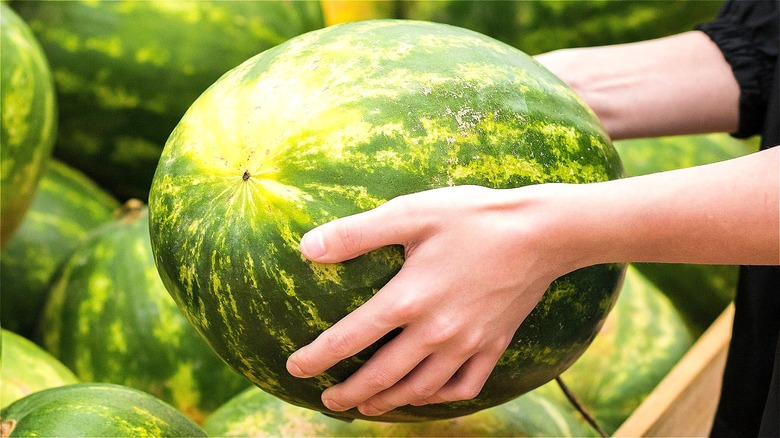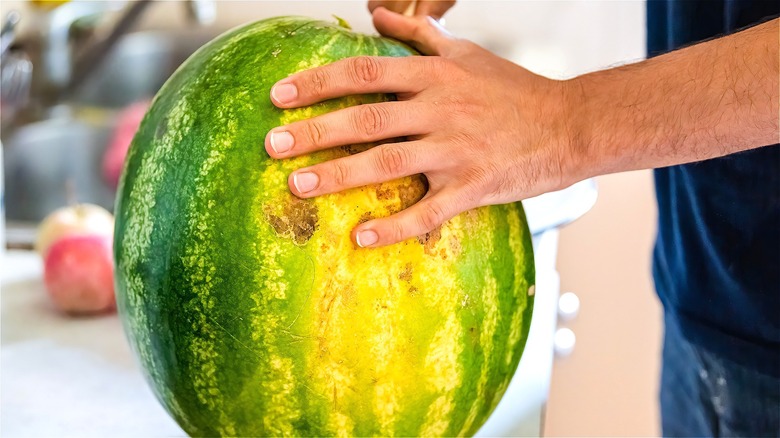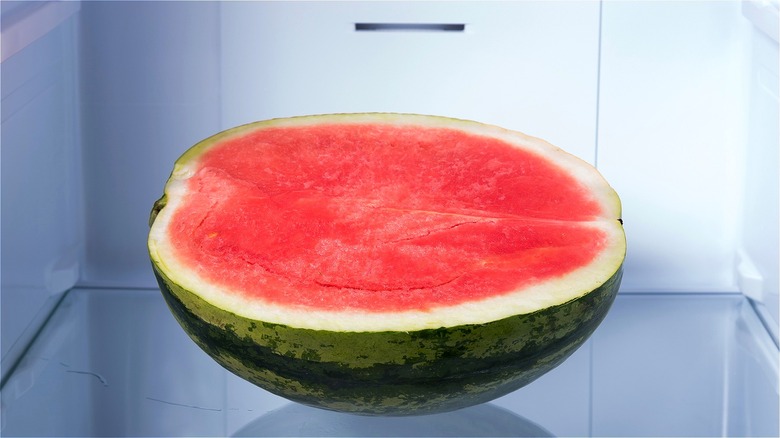The One Thing You Need To Remember Before Buying Fresh Watermelon
What better way to enjoy the variety of seasonal summer produce farm stands and supermarkets have to offer than to partake in the consumption of perfectly sweet and juicy watermelon? Next to peaches, plums, and blueberries, seeing a mountain of watermelons in the produce section of your neighborhood grocery store means that now is the time to enjoy refreshingly ripe melon before summer comes to a close. Yet, besides picking the most visually appealing fruit in the lot, there is one thing you should keep in mind as you make your selection: watermelon doesn't continue to ripen once it's been picked from the vine. Therefore, next to adequate storage, being particular when choosing which watermelon to take home makes all the difference.
Just like cherries and strawberries, watermelons are non-climacteric fruits meaning they only ripen when attached to their central stems. Since watermelon doesn't ripen after harvest, the flavor of that bright pink flesh is already as sweet as it will ever be. Among the many watermelons you'll sift through to find the right one, steer clear of melons that have green stems attached. This is a clear indication that the watermelon in question has been harvested before fully ripening. Stemless watermelons are a good sign of maturation, indicating that the fruit was able to easily detach from the vine. Now that you know your recently purchased watermelon won't ripen on your counter or in your refrigerator, taking extra time to make your selection is essential.
How to spot a ripe watermelon
Next to looking out for green stems, there are other simple ways to efficiently detect a ripe watermelon at the point of purchase. As you sift through the options, look for watermelons that have a large yellow patch of skin along the rind. Known as ground spots, this is the base in which watermelons sit and mature. Yellow spots indicate a mature watermelon, while white spots may signify melons that have been picked prematurely.
Moreover, how shiny the exterior of your fruit is may also indicate a melon's ripeness. Watermelons with a dull or cloudy green color may indicate melons that have been grown with ample sun exposure whereas shiny watermelons may point to immaturity. Beyond judging watermelons based on their color and amount of sheen, you also want to avoid watermelons with visible soft spots, signs of mold, or cuts.
You also want to make sure to judge the weight and feel of your watermelon. A heavier watermelon typically means a juicier fruit. Choose a watermelon with a firm exterior. To go one step further, you may want to gently smack the side of your watermelon and listen for a hollow, echoing sound to detect if your fruit is prime for eating. If the smack produces more of a straightforward clear thump, this could mean your fruit was picked too early. Now that you know how to pick the perfect watermelon, what is the best way to retain this ripe melon's inherent sweetness?
Use proper storage to preserve the taste and texture of your watermelon
If you get lucky with a watermelon that's prime for eating but want to maintain or prolong the shelf-life of your fruit, there are a few factors worth considering. Whole watermelons thrive best at a cooler temperature of 55 degrees and stay fresh for one to two weeks post-harvest. While you can extend your fruit's shelf-life by placing whole melons in your refrigerator, this may have a negative impact on watermelon's internal quality. This is in part, due to certain fruits and vegetables in your refrigerator.
Like the fruits and veggies you should never store near your potatoes, watermelon is affected by ethylene emitting produce. If placed in close proximity to foods like tomatoes or apples, the quality of your watermelon can decrease at a rapid rate. General refrigeration can also dull the taste and nutritional qualities of watermelon over time.
To maximize on the flavor and nutritional benefits of this refreshing fruit, you're better off consuming watermelon as close to the purchase date as possible. Store whole watermelons at room temperature for up to 10 days. Cut watermelon should be stored in airtight containers in the refrigerator to retain its sweet flavor and juicy consistency. While you can't alter the ripening process of whole watermelons off the vine, proper selection and careful storage ensure your enjoyment of this seasonal fruit all summer long.


